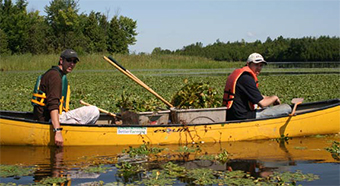Water chestnut
What you need to know about the water chesnut. Includes habitat, identifying features and what you can do to reduce its impact.
European Water Chestnut (Trapa natans)
European water chestnut is an invasive aquatic plant that has been introduced to a section of the Ottawa River in eastern Ontario within Voyageur Provincial Park. The plant is native to Europe, Asia and Africa, and is used in North America as an ornamental water garden plant. Although it’s not certain how the plants arrived in the Ottawa River, it could possibly be the result of a water garden plant(s) being improperly released or a boat contaminated with water chestnut being launched within or near the park.

Range
Water chestnut was introduced into North America sometime before 1879 by a gardener at the Cambridge Botanical Garden in Massachusetts. The gardener reported planting it in several ponds. Since then, water chestnut has spread to other states in the northeast. It has also been found in Quebec, and in tributaries of the Niagara River and Lake Ontario in New York State. The population in the Ottawa River is the only known population in Ontario.
Impacts of water chestnut
Water chestnut populations in the Ottawa River, as well as neighbouring provinces and states have become a serious nuisance causing a number of impacts, including:
- Forms extremely dense floating mats of vegetation that shade out native vegetation, decreasing plant biodiversity, and making recreational activities like swimming, angling, and boating almost impossible in the infested areas.
- The hard nuts with barbed spines can accumulate on shore and cause injury when stepped on.
- Reduced light penetration and plant growth beneath the water chestnut canopy, combined with a large amount of decomposing vegetation below, can lead to decreased dissolved oxygen levels, which can impact native species and cause fish kills.
Since the water chestnut population in the Ottawa River is the only known population in Ontario, it’s very important that we put every effort towards removing this plant before it spreads to other locations. The ministry, with support from partnering agencies, are working to eradicate water chestnut from the Ottawa River by pulling the plants by hand, with rakes and mechanical harvesters. Efforts to control this new invader are ongoing.
How to identify water chestnut

Water chestnut has an appearance unlike any other plant species in Ontario. Features that can be used to identify water chestnut include:
- Floating leaves.
- The leaves are green, with sharply toothed edges.
- The leaves form a densely crowded rosette up to 30 cm in diameter.
- The leaf stems are up to 15 cm long, with a spongy swollen section that helps the plant float.
- Underwater leaves are feather-like with finely dissected leaf segments.
- The flowers are small (8 mm long), white, and have four petals.
- Produces a hard “woody” nut (seed), 3-4 cm wide with sharp barbed spines. Viable seeds are greenish brown and sink to the bottom. Older seeds are black, floating, and are not viable.
- The nuts bear no resemblance to the “water chestnut” used in Asian cooking.

What can I do
- Learn how to identify European water chestnut and how to prevent accidentally spreading the plants and seeds. This is especially important if you are planning to do work or participate in recreational activities in the Ottawa River in the area that contains water chestnut.
- Do not plant European water chestnut in your water garden. Water gardeners should use only native or non-invasive plants and are encouraged to ask garden centres for plants that are not invasive.
- Never release unwanted aquarium plants or pets into any waterbody. Return or donate unwanted plants or pets to a pet store or garden center, a school or a friend.
- Always inspect your boat and boating equipment, and remove any plants or animals that are visible before leaving the waterbody.
- To prevent spreading plants and seeds to new locations avoid boating through the area around the Ottawa River that contains European water chestnut.
- Report sightings to the Invading Species Hotline
1-800-563-7711 or visit Ontario’s Invading Species Awareness Program

Other resources
- Ontario Invasive Plant Council
- Stop the spread of invasive species
- Ontario’s Invading Species Awareness Program
For more information:
Please contact the Invading Species Hotline at
Cette publication est également disponible en français.